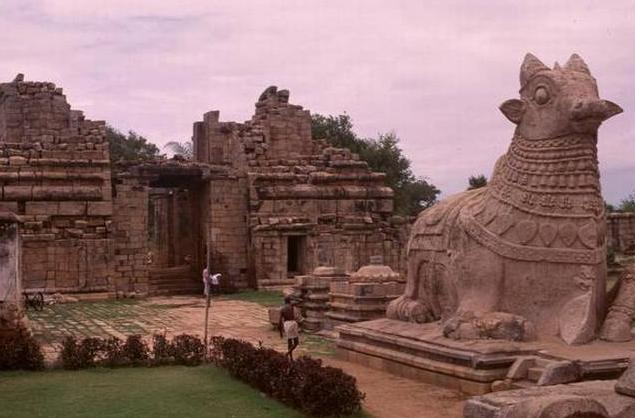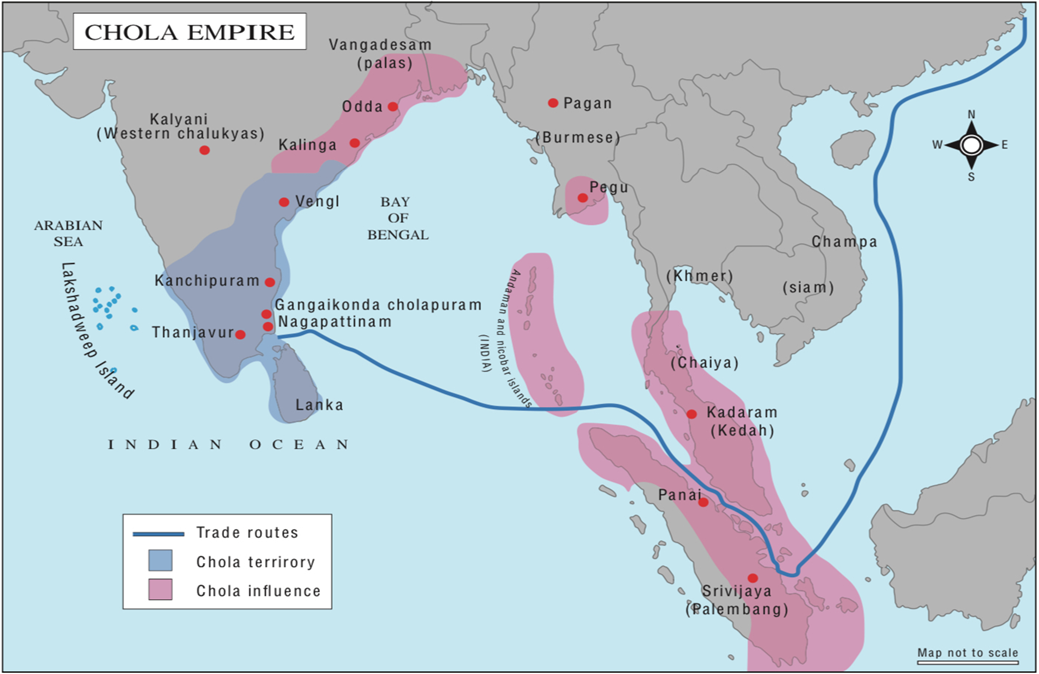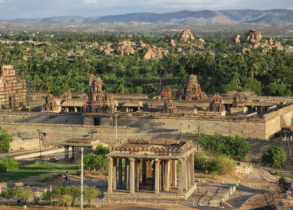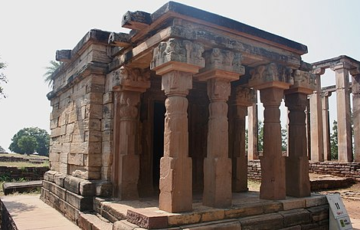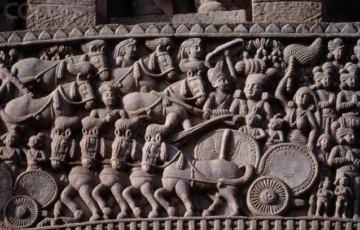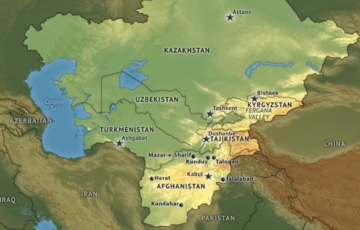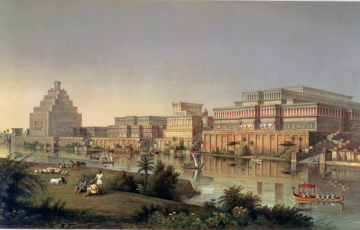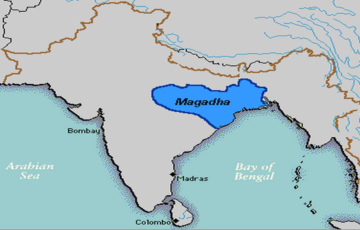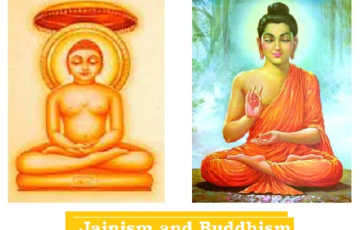SANGAM AGE
Introduction
The Sangam Age extends from the 3rd century BC to the 3rd century AD in South India, also known as Muchchangam.
Sources to study Sangam Age
| Archaeological | ● Megalithic burials of South India
○ Buried their dead in urns made of red pottery, mostly not surrounded by stones, on slopes of the hills. ■ Cist Burial: Involves placing the bodies of the deceased in small stone-built coffin-like boxes, which are buried entirely underground. ■ Urn Burial: Following death, the bodies are cremated, and the resulting ashes are collected and placed inside urns for burial. ○ These people produced Paddy and ragi because of less land available for cultivation. ● Historic ports & capitals (Arikamedu, Kodumanal, Uraiyur, Alagankulam). ● Buddhist stupas and chaityas (Amaravati, Nagarjunakonda) in Andhra and Karnataka. |
| Numismatic | ● Pre-Satavahana and Satavahana coins in Andhra-Karnataka.
● Coins of Cheras, Cholas, Pandyas, Sangam chieftains. ● Roman copper, silver, gold coins. |
| Epigraphic | ● Asokan inscriptions in Prakrit found in Andhra-Karnataka.
● Tamil-Brahmi inscriptions found in the caves of Tamil Nadu and Kerala at Mangulam, Jambai, and Pugalur. ● Satavahana & Buddhist inscriptions of the Andhra region ● Short inscriptions on pottery, rings, and stones in Tamil Nadu and international sites like Berenike, Quseir al Qadhim. |
| Literary | ● Tamil texts (Sangam, post-Sangam).
● Kautilya’s Arthasastra on economy, statecraft. ● Puranas with Andhras/Satavahana genealogy. ● Buddhist Chronicles like Mahavamsa. ● Gatha Saptasati, a Prakrit text by Satavahana king Hala. ● Classical Tamil Literature ○ Tolkappiyam 5 epics belong to post-Sangam times (fourth to sixth century CE) |
| Foreign Notices | ● The Periplus of Erythrean Sea, an ancient Greek text of the 1st century CE.
● Pliny the Elder’s Natural History, 1st century CE ● Ptolemy’s Geography, 2nd century CE ● Vienna Papyrus, a Greek document dated to the 2nd century CE. ● A Roman Map called Peutingerian Table |
South India during Mauryan times
Asokan edicts (c. 270-30 BCE) reveal south India’s political landscape.
- Rock Edict II: It mentions neighboring Tamil rulers like Cholas, Pandyas, Keralaputras and Satiyaputra and provisions for medical treatment for humans and animals.
- Between Mauryan decline and Satavahana rise, small principalities emerged, evidenced by coins and inscriptions.
The Sangam Age
- Three dynasties ruled during the Sangam Age – the Cheras, Cholas and Pandyas.
- The Pandyas are believed to have patronized the Tamil Sangams, facilitating the compilation of Sangam poems.
three Sangams over the years
| S. No. | Number of years | Place of Sangam | President of Sangam | Other scholars | Important Works |
| 1 | 4400 | Thenmadurai | Sage Agastyar | Agastya, Murugavel, Mudinagarayar and Murunjiyur | Agatiyam, Paripadal, Mudukurugu and Kalariyavirai |
| 2 | 3700 | Kapadapuram | Agastya
|
Irundiyar, Tolkappiyar, Karungoli, Pandurangan, Tarainamaran, and Vellurkappiyanar | Tolkappiyam Mapuram, Isainunukam, Bhutapuram, Kali, Kuruku and Vendali |
| 3 | 1850 | Madurai | Nakkiralu | Thiruvalluvar, Valluvar, Ilango Adigal, Seethalai Sathanar, Nakkiranar, Kapilar, Paranar, Auvaiyar, Mangudi Marudanar | Pattupattu, Ettutogai, PathinenKilkanakku, Silapathikaram and Manimeghalai and the Kural, Thirukkural |
Sangam texts:
Ettuthogai and Pathupattu collections have about 2400 poems composed by panar (wandering bards) and pulavar (poets).
| Ettuthogai
(Eight Anthologies) |
1. Natrinai
2. Patitruppathu 3. Akananuru 4. Kurunthogai 5. Paripadal 6. Purananuru 7. Aingurunuru 8. Kalithogai |
| Pathupattu
(ten long songs) |
1. Thirumurugatrupatai
2. Maduraikanchi 3. Porunaratrupatai 4. Nedunalvadai 5. Sirupanatruppatai 6. Kurinjipattu 7. Perumpanatruppatai 8. Pattinappalai 9. Mullaipattu 10. Malaipadukadam |
Other works:
PatinenKilkanakku texts include eighteen texts, and deals with ethics and moral codes.
- Thirukkural by Tolkappiyar (Tamil grammatical text) and
- Silappadikaram by Ilango Adigal and Manimekalai by Seethalai Sathanar are the two important epics useful for insights into cultural and religious history
- “Silappadikaram” narrates a love story involving Kovalan, a dignitary, who chooses Madhavi, a courtesan from Kaveripattanam, over his wedded wife Kannagi, who hails from a noble family.
- “Manimekalai” follows the adventures of the daughter born to Kovalan and Madhavi, exploring her journey and experiences.
Women Poets of the Sangam
- There were thirty women poets who composed more than 150 poems.
- The most prominent was Avvaiyar.
- Others include Allur Nanmullaiyaar, Kaakkaipadiniyar, Kavarpendu, Nalveliyaar, Okkur Masaathiyar, and Paarimakalir.
The Muvendar or three crowned kings
- They governed agrarian lands, commerce, and urban areas.
- Produced valuable goods: pepper, ivory from elephants, pearls from the sea, and precious gems appreciated in the West. Also Created muslin and silk.
- Engaged in trade with Hellenistic Egypt, Arabia, and the Malay archipelago.
| Dynasty | Region | Ancient Capital | Important Ruler | Important Ports | Emblem |
| Cheras | Kerala | Vanji | Cheran Senguttuvan | Musiri, Tondi | Bow and Arrow |
| Cholas | Tamil Nadu | Uraiyur, Puhar | Karikala | Kaveripattinam | Tiger |
| Pandyas | Tamil Nadu | Madurai | Nedunchezhiyan | Muziris (Muchiri), Korkai, Kaveri | Fish |
The Cholas
They ruled central & northern Tamil Nadu mostly Kaveri delta later known as Cholamandalam or Coromandel. Present in North-east territory of Pandyas.
- Capital: Uraiyur (Known for cotton trade)
- The inaugural monarch to rule from Uriyur was Uruvappahrer Ilam Set Senni.
- State emblem: Tiger
- In the 2nd Century BC, King Elara conquered Sri Lanka and ruled over 50 years.
| Karikalan: The famous Chola king in around 100 A.D.
● He is the son of Ilanjetchenni and became the king at the age of five. ● He was also called Tirumavalan. ● He transferred the capital to Puhar (also called Poompuhar) or Kaveripattinam ○ an alternate royal residence & a major port. ● Rewarded poets generously with cash, gold pieces, land, chariots, horses, and elephants ● Pattinappalai by poet Katiyalur Uruttirankannanar describes trade prospered under him. ○ Karikalan rewarded him with gold coins ● His key military achievement: defeating Cheras, Perum Cheralathan, Pandyas, with the support from 11 Velir chieftains at Venni (Battle of Venni). ○ In the 2nd battle at Vagaipparandalai, he defeated Nine Princes. ● He exerted pressure on the Pallavas of Kanchi and Kurumbras, making them acknowledge Chola suzerainty. ● He converted forests into habitable areas. ● He built Killanai across Kaveri river and many irrigation tanks. ○ Kallanai, or the “Grand Anicut,” is an ancient dam on the Kaveri River in Tamil Nadu. ● He had also advanced agriculture via Kaveri embankment and building reservoirs. ● Karikalan’s death led to a succession dispute between Puhar and Uraiyur Chola branches. ● King Perunarkilli conducted the Vedic Rajasuyam sacrifice. |
The Cholas weakened as the Cheras and Pandyas expanded; Pallavas further diminished their influence from the 4th to 9th century AD.
The Cheras
- Cheras governed central & northern Kerala and Kongu region in Tamil Nadu.
- 2 main Chera branches: 1st branch ruled Vanji and 2nd Poraiya branch ruled Karur.
- Controlled west coast ports like Musiri, Tondi.
- Vanji is identified as Karur in Tamil Nadu or Tiruvanchaikkalam in Kerala by scholars.
- State emblem: ‘bow and arrow’ (featured in coins)
- Pugalur inscriptions near Karur mention 3 generations of Chera kings.
- Prominent kings include Imayavaramban, Nedun-cheralathan and Chenguttuvan.
- Patitrupathu discusses 8 Chera kings, their territories, and fame.
- Chellirumporai minted coins in his name.
- Some Cheras issued copper and lead coins with Tamil-Brahmi legends, imitating Roman coins.
Important kings
| Udiyan Cheral | ● The Chera Kingdom’s earliest ruler, he lived during the reign of Satavahana King Satakarni II, whom he defeated and earned the title “Udayan of the big feed.”
● His son Nedum Cheral Adan, succeeded him. |
| Nedum Cheral Adan | ● He had to confront the Yavanas, whom he defeated and earned the title “Imayavaramban” through their humiliation.
● During his reign, he engaged in a fatal one-on-one battle with Chola King Verpahradakki Peru Virar killi, where both monarchs killed each other. ● He had two sons: Cheran Chenguttuvan and Ilango Adigal. ○ Ilango Adigal, the younger, became an ascetic and authored the ‘Silappadikaram,’ immortalizing his royal brother. |
| Chenguttuvan (the Red Chera) | The prominent ruler
● He defeated numerous chieftains and protected the port of Musiri from piracy. ● He led a great north Indian expedition, mentioned in Silappathikaram, but not found in Sangam poems. ● He was contemporary to Yagnasri Satakarni of Satavahanas ● He defeated the pirates known as ’Kadambas’ and earned the title ‘Kadal-Pirakka Hiya’. ● He ruled for 46 years and supported both orthodox and heterodox religions. ● He introduced the Pattini cult in Tamil Nadu, venerating Kannagi as the exemplary wife, ● He initiated the first diplomatic mission to China from South India. |
After the 2nd century, Chera kingdom declined.
The Pandyas
- Capital – Madurai and Main port – Korkai
- Korkai is mentioned in the Periplus as “Kolkoi”, known for pearl fishery and chank diving.
- Megasthenes mentioned about the Pandya kingdom being famous for pearls.
- Pandya society was matriarchal.
- State Emblem: The fish (a double carp inscribed on their flags)
- The Pandya rulers benefited from Roman trade, dispatching envoys to Emperor Augustus.
- They invaded Southern Kerala and controlled the port of Nelkynda near Kottayam.
- Horses were imported by sea into the kingdom.
- The Mangulam Tamil-Brahmi inscription references a Pandya king named Nedunchezhiyan from the second century BCE.
Important Kings
| Vadimbalambaninra | He is also known as Nediyon and is the earliest king of the Pandyas. |
| Padagasalai Mudukudumi – Peruvazhuthi | ● A formidable warrior, poetry patron.
● Maduraikanchi of Mangudi Marudan mentions him. ● Mentioned in Velvikkudi copper plates of the eighth century, donated land to Brahmans and issued coins with the legend “Peruvazhuthi” to commemorate Vedic sacrifices. |
| Nedunchezhiyan | ● He is celebrated for his victory over a combined army of the Chera, Chola, and five Velir chieftains at Talayalanganam.
● bore the title of ‘Aryappadaikadanda’ ● He also captured Milalai and Mutthuru from a Vel chief. |
The Pandyan rule began to decline due to the invasions of the Kalabhras.
Sangam Polity
- The thinai classification reflects varying socio-economic developments in different localities during the Sangam Age.
- This classification also extends to political forms with three levels of rulers:
| Kizhar | Village or small territory leaders, later known as nadu chiefs, overseeing tribal communities in specific areas. |
| Vendar | Kings who controlled larger and fertile territories.
● They adopted titles like Kadungo, Imayavaramban, Vanavaramban, and Peru Vazhuthi to distinguish themselves. ● Kings patronized bards and poets, entertaining them in their courts (avaiyam) to enhance their reputation and glorify their territories. ● He had absolute powers over his subjects. Kings conducted Vedic sacrifices. ● Vendar wars aimed to expand their territories by annexing enemy lands. ● Hereditary monarchies didn’t always follow primogeniture for succession. ● King was advised by committee known as “Aimperunkulu ” comprised Amaichchar (Ministers), Priests (anthanar), Generals, Envoys (Dutas or thuthar), and Spies (orrar). ○ He was also advised by the imperial court i.e. Orasavai or Vettavai and court poets. ● The kings of Sangam age rulers ruled with different titles like Vanavaramban, Vanavan, Villavar (Chera rulers), Senni, Valavan and Killi (Chola rulers), Thennavar and Minavar (Pandya rulers) |
| Velir | ● Many chiefs governed varied, hilly, and forested territories between fertile muvendar lands.
● Notable Velir leaders like Athiyaman, Pari, Ay, Evvi, and Irungo ruled resource-rich regions, patronizing poets. They held military might, often clashing and occasionally uniting against the main kings. ○ Satiyaputra (Athiyaman) in Asokan inscription is a Velir chief in Sangam poems. |
| Vattakirutal | A monarch who suffered defeat in a battlefield, chose to perform a ritual suicide by fasting until death. |
Sangam Society
- There were pronounced social inequalities during the Sangam era.
- The affluent dwelled in brick and mortar houses, while the poor lived in huts and simpler structures.
- Brahmanas
- They first appeared during the Sangam era in Tamil land.
- They consumed meat and wine.
- Captains of the army received the title “Enadi.”
- Vallalas, or rich peasants, held civil and military offices under both Cholas and Pandyas.
- The ruling caste was referred to as Arasar.
- Lowest-class women (kadaisiyar) performed agricultural work, akin to slaves.
- Low-class artisans (Pulaiyans) were responsible for crafting charpayis.
| Tamilagam five eco-regions known as “thinai” or (“land”, “genre”, “type”):
● Kurinji: Hilly region characterized by hunting and gathering activities. ● Marutham: Riverine tract where agriculture was practiced using ploughs and irrigation. ● Mullai: Forested region where pastoralism was combined with shifting cultivation. ● Neythal: Coastal land primarily used for fishing and salt production. ● Palai: Arid and parched land unsuitable for cultivation, leading people to engage in cattle lifting and robber. Each thinai had its distinct characteristics, including a presiding deity, people, and cultural practices that aligned with the environmental conditions of that region. Chief deities included Murugan, Subramaniya, and also Vishnu. |
Sangam Economy
- Revenue:
- Transit duties collected from merchants who moved their goods from place to place.
- King paid for the army, poets and priests, who were mainly brahmanas.
- Evidence of taxation is found at highways and in the port of Kaviripattinam.
- Agriculture:
- Produced paddy, ragi and sugarcane
- Tamil region produced grains, fruit, pepper and turmeric
- Craft production: Bronze vessels, beads, goldwork, textiles, shell bangles, ornaments, glass, iron smithy, and pottery making.
- Hubs for craft production: Urban centers like Arikamedu, Uraiyur, Kanchipuram, Kaviripattinam, Madurai, Korkai, and Pattanam in Kerala
- “Maduraikanchi” describes day and night markets offering diverse crafted items.
- Trade: The scarcity of raw materials led to the exchange of gemstones in a prevalent barter system.
- Hubs for craft production: Urban centers like Arikamedu, Uraiyur, Kanchipuram, Kaviripattinam, Madurai, Korkai, and Pattanam in Kerala
- Barter was common in trade, alongside the use of coins.
- Roman gold and silver coins found in hoards in southern India, including Coimbatore.
- Evidence of Long distance trade:
- Archaeological sites demonstrate long-distance trade, including links to the Roman Empire and Southeast Asia.
- Early historic ports revealed Roman amphorae, glassware, indicating active maritime trade.
- Pottery inscriptions indicate non-Tamil-speaking traders in Sangam Age craft centers and towns.
- Sangam text “Manimegalai” mentions Magadha artisans, Maratha mechanics, Malva smiths, and Yavana carpenters working with Tamil craftsmen.
- Trade-related terms like vanikan, chattan, and nigama appear in Tamil-Brahmi inscriptions.
- Umanar or salt merchants, traveled in bullock carts with their families for trade.
- Chattu referred to mobile merchants or itinerant traders.
Army
- The state sustained a standing army funded by taxes levied on the peasantry.
- This army comprised various units including chariots pulled by oxen, elephants, cavalry, and infantry.
- Nobles, princes, or captains typically rode elephants, while the commander would often lead from a chariot.
Arguments for the Cheras, Cholas, and Pandyas being pre-state chiefdoms:
- Lack of social stratification.
- Absence of clear territorial associations.
- Destructive warfare hindering agricultural surplus production.
- No evidence of taxation, unlike North Indian governments.
Counter-arguments supporting the existence of organized states:
- According to Sangam literature, Social differentiation is evident in the Marutham region.
- The Muvendar exhibit clear territorial associations, supported by Greco-Roman texts from the first century CE.
- Territorial expansion through warfare was a prominent theme in Puratthinai.
- Trade played a significant role between the late first century BCE and the third century CE, indicating economic organization and governance.
Ideology and Religion
Buddhism
- The emergence of formal religious activities can be traced back to the time of Asoka, during which Buddhism spread to South India and Sri Lanka.
- Legend has it that Asoka’s daughter brought a Bodhi tree to Sri Lanka.
- There are legends suggesting Chandragupta Maurya’s presence in Karnataka before Asoka’s reign.
- Buddhism made a significant impact in South India, particularly in the Krishna and Godavari delta regions of Andhra Pradesh. Archaeological sites such as Amaravathi and Nagarjunakonda offer evidence of this influence.
- In Tamil Nadu, Kaviripattinam and Kanchipuram have remnants of Buddhist Stupas, although Buddhism is less widespread compared to Jainism.
Jainism
- Jainism had a robust presence in Tamil Nadu, as indicated by the existence of numerous cave shelters adorned with Tamil Brahmi inscriptions.
- While the extent of their influence on the general populace remains uncertain, there is evidence suggesting that merchants and devotees supported Jain monks by offering rock shelters and other provisions.
- In the post-Sangam era, Jains made noteworthy contributions to Tamil literature, enriching the cultural and literary landscape of the region.
Brahmanism
- The onset of Brahminism can be traced back to the support of Vedic sacrifices by prominent rulers such as the Satavahanas, Sangam kings, and Ikshvahus, as documented in Sangam texts.
- Sangam texts also provide evidence of Brahmin migration and the performance of Vedic rituals, although the varnasrama ideology had not firmly established itself in Tamil Nadu at that time.
- Additionally, the worship of Vishnu is mentioned in these texts, indicating a diverse religious landscape.
- Despite the influence of Brahminism, the megalithic tradition of providing offerings for the dead, such as paddy, persisted.
- While cremation was introduced, inhumation (burial) remained a practiced funerary rite.
- Local deities like Murugan, also known as Subramaniya, continued to be revered by the populace alongside the emerging Brahminical practices.
Age of Kalabhras – Post Sangam Period
- The period between the Sangam Age and the Pallava-Pandya era (approximately 300 CE to 600 CE) is known as the Kalabhra age in Tamil history.
- Traditionally considered a “dark age” due to the disappearance of the three traditional Tamil kingdoms,
- It was during this period that significant Tamil literary works were produced, including the Tirukkural, Silappathikaram, and Manimekalai.
- Jainism and Buddhism gained influence during this time, leading orthodox Vedic-Puranic scholars to depict the Kalabhra rulers negatively. Later the rulers embraced the orthodox Vedic-Puranic religion, particularly the Bhakti cults of Saivism and Vaishnavism.
- Recent interpretations view this era as a transition period, with the emergence of larger state societies under the Pallavas in northern Tamil Nadu and the Pandyas in the south.
- The influence of Jainism and Buddhism on society remained strong, leading to some resistance from Bhakti saints.
- Inscriptions at Pulangurichi in Sivagangai district mention two kings, Chendan and Kurran, identified by some as Kalabhra rulers.
- The Kalabhra kingdom was eventually overthrown by the Pandyas in the mid-sixth century CE.
UPSC PREVIOUS YEAR QUESTIONS
1. Which one of the following explains the practice of Vattakirutal as mentioned in Sangam poems? [UPSC CSE 2023]
a) Kings employing women bodyguards
b) Learned persons assembling in royal courts to discuss religious and philosophical matters
c) Young girls keeping watch over agricultural fields and driving away birds and animals
d) A king defeated in battle committing ritual suicide by starving himself to death
2. With reference to the cultural history of medieval India, consider the following statements: [UPSC CSE 2016]
1. Siddhas (Sittars) of Tamil region were monotheistic and condemned idolatry.
2. Lingayats of Kannada region questioned the theory of rebirth and rejected the caste hierarchy.
Which of the statements given above is/are correct?
a) 1 only
b) 2 only
c) Both 1 and 2
d) Neither 1 nor 2
| IMPORTANT FACTS RELATED TO THE CHAPTER
● The Brihadeeshwara temple is a magnificent example of the Dravidian style of temple architecture and is associated with the Chola dynasty, particularly constructed during the reign of Rajraja-I. ○ It is renowned as the largest and tallest temple in India, with a massive sanctum covering an area of 500′ x 250′. ○ The temple features two idols of ‘Dwarpals’ guarding the main shrine, and a gigantic ‘Nandi’ statue, carved out of a single rock, which is believed to be the tallest Nandi idol in India. ● The functioning system of the executive committee of the Gram Sabha (village assembly) in Chola village administration is detailed in the Uttaramerur inscription. ○ Each village had its own committee called ‘Sabha,‘ which operated independently of central command and autonomously managed village affairs. ○ In Chola-era village administration, a working committee overseeing various activities was known as Variyam. ○ Different types of Variyams were responsible for specific tasks, such as Thotta Variyam for the Horticulture Board, Samvatsara Variyam for annual activities, Eri Variyam for managing tanks and water supply, and Pan Variyam for handling financial matters. ● The Chola dynasty was founded by Parantak-I in Southern India after defeating the Madura King and assuming the title of “Madurai-Kond.” ○ Rajaraja-I, according to the Thanjavur inscription, achieved victories over the Cheras naval army in Kandalloor and launched expeditions against the Sailendra empire in Southeast Asia, conquering several territories due to trade difficulties with China. ● Chola artists (Sthapatis) were renowned for their skill in carving stone and metal sculptures. ○ They crafted numerous bronze sculptures, including elegant idols of Nataraja (Shiva), considered among the finest sculptures in the world. ● The Dakshinamurti idol of Shiva, portraying him as a mentor or teacher, is installed facing the south direction, symbolizing the dissemination of knowledge to devotees. ● During the reign of Chola king Kulottunga-I, a goodwill mission consisting of 72 traders was sent to China in 1077. ● Agastya is revered as a sage who played a significant role in the Aryanization of South India. ○ According to tradition, he traveled south at the behest of the gods and settled there, earning the title “Father of Tamil Literature.” ○ His influence on Tamil culture and literature is profound, and he is often depicted as a revered figure in Tamil Nadu. ● Tolkappiyam serves as a treatise on grammar and poetry. The author, Tolkappiyar, is believed to have been one of the twelve disciples of the sage Agastya. ○ It is written in a formulaic style and provides valuable insights into the linguistic and literary traditions of ancient Tamil Nadu. ● Uraiyur, located on the banks of the Cauvery River in Tiruchirappalli was a prominent town during the Sangam era. ○ Also known as Koli and Varanam, it was a major center for cotton production and trade. ○ References to Uraiyur can be found in ancient texts such as the “Periplus of the Erythraean Sea,” which lists it among various ports along the western coast. ● The Battle of Takkolam was a significant military engagement between Rajaditya, son of the Chola king Parantaka I, and a confederacy of western Gangas and Vaidumbas led by Rashtrakuta King Krishna III. ○ It took place at Takkolam and had strategic implications for the political landscape of the region. ● The Vengi River, originating near Madurai, Tamil Nadu, was integral to the Pandya state’s prosperity. It flowed through the region, enhancing fertility and supporting agricultural activities. ○ The Pandya state, with its capital in Madurai, encompassed modern-day Madurai and parts of Travancore. ● Siddhas are associated with the Sangam period and are closely linked with the origin and development of Shaivism, Siddhanta philosophy, and Tantric practices in South India. ○ They emphasized monotheism and rejected idolatry, influencing religious and philosophical thought in the region. ● Arikamedu is an archaeological site in Pondicherry, Southern India, known for its connections to the Roman Empire. ○ Artefacts found at Arikamedu, including an intaglio depicting Augustus Caesar, beads, and gems, suggest trade and cultural exchanges between the region and the Roman world. ○ References to Arikamedu can be found in ancient texts like the “Periplus.” |

